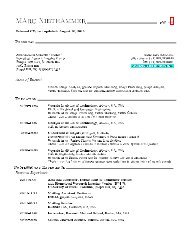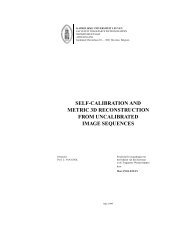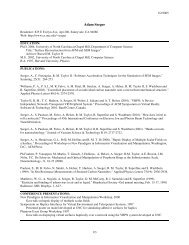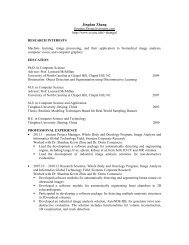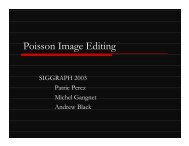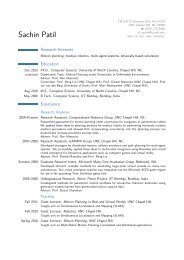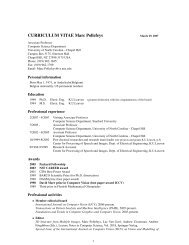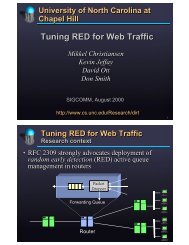Colorization: History
Colorization: History
Colorization: History
Create successful ePaper yourself
Turn your PDF publications into a flip-book with our unique Google optimized e-Paper software.
<strong>Colorization</strong>
<strong>Colorization</strong>: <strong>History</strong><br />
• Hand tinting<br />
– http://en.wikipedia.org/wiki/Hand-colouring
<strong>Colorization</strong>: <strong>History</strong><br />
• Film colorization<br />
– http://en.wikipedia.org/wiki/Film_colorization<br />
<strong>Colorization</strong> in 1986<br />
<strong>Colorization</strong> in 2004
Overview<br />
• <strong>Colorization</strong> by example<br />
• <strong>Colorization</strong> using “scribbles”
Transferring Color to Greyscale Images<br />
T. Welsh, M. Ashikhmin, and K. Mueller<br />
SIGGRAPH 2002
The Basic Approach<br />
• Convert source image to decorrelated lαβ color space<br />
– l: luminance<br />
– α, β: chromatic channels (yellow/blue and red/green)<br />
• Perform luminance remapping (histogram matching)<br />
• Take ~200 color samples from the source image<br />
• For each pixel in the target image (in scanline order):<br />
– Find best matching source pixel (compare luminance and std. dev.<br />
of luminance values in neighborhood)<br />
– Transfer color from source pixel to target pixel<br />
source target result
Recall: Image Analogies
Problem<br />
• Global procedure fails when corresponding<br />
colors don’t have corresponding luminance<br />
values<br />
Source image Target image Colorized target<br />
Grayscale source<br />
image
Solution<br />
• The user specifies corresponding swatches in<br />
the source and target images
<strong>Colorization</strong> with swatches<br />
Transfer between<br />
swatches<br />
Global transfer Extend to the<br />
rest of image
<strong>Colorization</strong> with swatches: Details<br />
• Transfer color from source to target swatches<br />
– Perform luminance remapping between corresponding<br />
swatches<br />
– Take ~50 samples from each source swatch<br />
• Extend colorized swatches to the rest of image<br />
– For each grayscale pixel, find best matching pixel in a<br />
colorized swatch in the target image<br />
• Matching function is SSD of grayscale neighborhoods<br />
– Transfer color from matching pixel to grayscale pixel
Example results
Example results
Example results: Scientific visualization
Video colorization<br />
• First transfer color between swatches for a<br />
single frame<br />
• Use the colorized swatches in the single<br />
frame to transfer color to the rest of the<br />
sequence
Video colorization results
Video colorization results
Brain volume colorization
Discussion of implementation choices<br />
• Effect of color space<br />
• Sampling scheme for source pixels<br />
• Matching function between source and<br />
target pixels<br />
• Additional constraints for search (i.e., spatial<br />
coherence)<br />
• Selection of sample image
<strong>Colorization</strong> Using Optimization<br />
A. Levin, D. Lischinski, Y. Weiss<br />
SIGGRAPH 2004<br />
http://www.cs.huji.ac.il/~yweiss/<strong>Colorization</strong>/
Overview<br />
Input: grayscale image with color<br />
“scribbles”<br />
Output: Colorized image
The Approach<br />
• Two neighboring pixels r, s should have<br />
similar colors if their intensities are similar<br />
• The goal is to minimize the difference<br />
between the color U(r) at pixel r and the<br />
weighted average of the colors at<br />
neighboring pixels
Objective function<br />
sum over all pixels<br />
color of pixel r<br />
sum over pixels in<br />
the neighborhood of r<br />
affinity between<br />
r and s<br />
color of pixel s
Objective function<br />
Possible affinity functions:<br />
Neighborhood definition: for video, take optical flow into account<br />
Constraints: color of user-specified pixels remains fixed<br />
Optimization: sparse linear system
Results<br />
• Colors from the original image used for the<br />
“scribbles”<br />
• Processing time: ~15sec/frame
Comparison to segmentation-based colorization<br />
Segmented image Segmentation + flood fill<br />
<strong>Colorization</strong> by optimization
Recoloring<br />
Original image Mask and scribbles Final image
More recoloring<br />
Original image Scribbles Final image
Progressive colorization
Video colorization<br />
Grayscale video Input scribbles
Video colorization<br />
Grayscale video Colorized video
Video colorization<br />
Grayscale video Input scribbles
Video colorization<br />
Grayscale video Colorized video
Video colorization<br />
Grayscale video Input scribbles
Video colorization<br />
Grayscale video Colorized video
<strong>Colorization</strong> by Example<br />
R. Irony, D. Cohen-Or, and D. Lischinski<br />
Eurographics Symposium on Rendering, 2005
Motivation<br />
• Improve spatial consistency of examplebased<br />
transfer methods such as Welsh et al.<br />
(2002)<br />
• Reduce the amount of manual supervision of<br />
scribble-based methods such as Levin et al.<br />
(2004)
The importance of spatial coherence<br />
Source image Target image Image colorized by<br />
method of Welsh et al.
The importance of spatial coherence<br />
Source image Target image Proposed method
Overview of approach
Example result<br />
Reference<br />
(source) image<br />
Automatic<br />
segmentation<br />
Target image Pixel classification<br />
Smoothed pixel<br />
classification Colorized target
Example result<br />
Reference<br />
(source) image<br />
Target image<br />
Manual<br />
segmentation<br />
Automatic<br />
classification<br />
Colorized target<br />
image
Manual vs. automatic segmentation<br />
Source image<br />
Target image<br />
Manual<br />
segmentation<br />
Classification based<br />
on manual<br />
segmentation<br />
Automatic<br />
segmentation<br />
Classification based<br />
on automatic<br />
segmentation<br />
<strong>Colorization</strong>
Colorizing multiple frames
Natural Image <strong>Colorization</strong><br />
L. Qing, F. Wen, D. Cohen-Or, L. Liang, Y.-Q. Xu,<br />
H. Shum<br />
Eurographics Symposium on Rendering, 2007
Motivation<br />
• Reduce the amount of user interaction necessary<br />
to produce complex, nuanced color images<br />
• Handle highly textured images – non-adjacent<br />
regions of similar texture<br />
<strong>Colorization</strong> by optimization (Levin et al.)
Motivation<br />
• Reduce the amount of user interaction necessary<br />
to produce complex, nuanced color images<br />
• Handle highly textured images – non-adjacent<br />
regions of similar texture<br />
Proposed method
Outline of method<br />
1. The user draws strokes indicating regions that (roughly)<br />
share the same color<br />
2. Strokes are used for automatic texture segmentation<br />
3. The user selects color for a few pixels in each region<br />
4. Color is transferred automatically based on segmentation and<br />
selected colors
Segmentation<br />
• Iterative process: propagate labels to regions<br />
similar in intensity and texture, but not<br />
necessarily spatially contiguous
Color mapping<br />
• Piecewise-linear interpolation of selected<br />
colors inside each region<br />
• Soft blending of colors around the region<br />
boundaries
Comparison<br />
Levin result 1 Levin result 2 Proposed method
Comparison<br />
Proposed method<br />
Levin et al.
More results
More results
More results
Difficult example
Closeup
<strong>Colorization</strong>: Summary<br />
• Example-based methods<br />
– Transferring color to grayscale images (Welsh et al. 2002)<br />
• Shortcoming: spatial coherence<br />
– <strong>Colorization</strong> by example (Irony et al. 2005)<br />
• Spatially coherent texture segmentation<br />
• Stroke-based methods<br />
– <strong>Colorization</strong> using optimization (Levin et al. 2004)<br />
• Shortcomings: color leaking, too many strokes required for<br />
textured images<br />
– Natural image colorization (Qing et al. 2007)<br />
• Handle images with non-contiguous textures


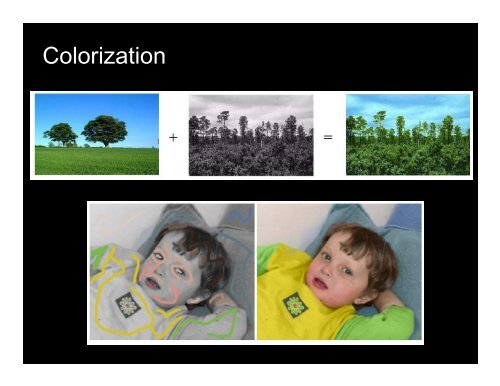



![Course description [PDF]](https://img.yumpu.com/21971997/1/190x245/course-description-pdf.jpg?quality=85)

